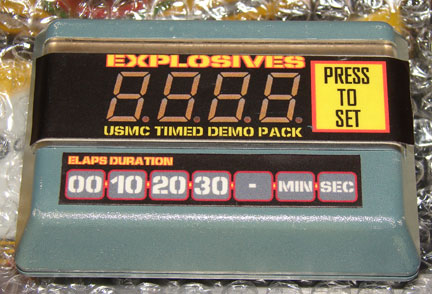Just wondering how hard it would be to make a specialty countdown timer to replicate a demolition pack as seen on a TV series.

It would need to have:
-4 digit LED number system.
-Push button activated to input times in 00, 10, 20, 30 increments as well as minutes and seconds.
So feasibly you could set the timer anywhere from 30 minutes, 30 seconds... to as little as 10 seconds?
-Reset button? (the little - symbol?)
-Push button to activate.
-Perhaps a "beep" sound when it "goes off"?
Total PCB size shouldn't be any larger than 3" x 2" to fit in the casing shown above.
Any ideas how hard they'd be to make, and possible costs involved?
Thanks!
Russ

It would need to have:
-4 digit LED number system.
-Push button activated to input times in 00, 10, 20, 30 increments as well as minutes and seconds.
So feasibly you could set the timer anywhere from 30 minutes, 30 seconds... to as little as 10 seconds?
-Reset button? (the little - symbol?)
-Push button to activate.
-Perhaps a "beep" sound when it "goes off"?
Total PCB size shouldn't be any larger than 3" x 2" to fit in the casing shown above.
Any ideas how hard they'd be to make, and possible costs involved?
Thanks!
Russ
Last edited:
